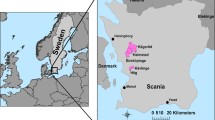Abstract
This paper addresses the intricate phenomenon of missing persons, a major problem in Mexico, extending beyond the simple occurrences of disappearances. By developing a historical and spatial data analysis, this research comprehensively examines missing person data from open, official, and social media sources. We apply a data mining framework based on digital media and openly accessible government databases to characterize and visually represent crimes such as enforced disappearances along the temporal and spatial dimensions. The data analysis methodology takes a comprehensive approach, segmenting data by age, sex, nationality, geographic location, and period. This segmentation unveils patterns in space and time, thus contributing to a better understanding of the factors influencing missing person phenomena and valuable insights into the dynamics of missing person incidents that have impacted many states and regions in Mexico over the past decade.
Access this chapter
Tax calculation will be finalised at checkout
Purchases are for personal use only
Similar content being viewed by others
References
Adeyemi, R.A., Mayaki, J., Zewotir, T.T., Ramroop, S.: Demography and crime: a spatial analysis of geographical patterns and risk factors of crimes in Nigeria. Spatial Stat. 41, 100485 (2021)
Laakkonen, V.: Deaths, disappearances, borders: migrant disappearability as a technology of deterrence. Polit. Geogr. 99, 102767 (2022)
Jiang, X., Mao, Z., Zheng, Z., Lin, Z., Wang, Y., Sheng, S.: Spatio-temporal characteristics of sexual crime and influencing factors of commercial service facilities: a case study of Haining City, China. Int. J. Law Crime Justice 76, 100647 (2024)
Ohyama, T., Hanyu, K., Tani, M., Nakae, M.: Investigating crime harm index in the low and downward crime contexts: a spatio-temporal analysis of the Japanese Crime Harm Index. Cities 130, 103922 (2022)
Kadar, C., Maculan, R., Feuerriegel, S.: Public decision support for low population density areas: an imbalance-aware hyperensemble for spatio-temporal crime prediction. Decis. Support Syst. 119, 107–117 (2019)
Leiva, M., Vasquez-Lavín, F., Oliva, R.D.P.: Do immigrants increase crime? Spatial analysis in a middle-income country. World Dev. 126, 104728 (2020)
Mata, F., Claramunt, C.: A mobile trusted path system based on social network data. In: Proceedings of the 23rd SIGSPATIAL International Conference on Advances in Geographic Information Systems, pp. 1–4 (2015)
Carrillo-Brenes, F., Vilches-Blázquez, L.M., Mata, F.: A proposal for semantic integration of crime data in Mexico City. In: Mata-Rivera, M.F., Zagal-Flores, R., Arellano Verdejo, J., Lazcano Hernandez, H.E. (eds.) GIS LATAM 2020. CCIS, vol. 1276, pp. 30–48. Springer, Cham (2020). https://doi.org/10.1007/978-3-030-59872-3_3
Instituto Nacional de Estadística y Geografía. Encuesta Nacional de Victimización y Percepción sobre Seguridad Pública 2021 (2023). https://www.inegi.org.mx/rnm/index.php/catalog/698/variable/F21/V1833?name=AP6_14. Accessed 10 Mar 2024
Inter-American Court of Human Rights (IACtHR). Case of Radilla Pacheco: Preliminary Objections, Merits, Reparations, and Costs Judgment of November 23, 2009. Series C No. 209. https://www.corteidh.or.cr/docs/casos/articulos/seriec_209_esp.pdf. Accessed 10 Mar 2024
Jalilifard, A., Caridá, V.F., Mansano, A.F., Cristo, R.S., da Fonseca, F.P.C.: Semantic sensitive TF-IDF to determine word relevance in documents. In: Thampi, S.M., Gelenbe, E., Atiquzzaman, M., Chaudhary, V., Li, K.-C. (eds.) Advances in Computing and Network Communications. LNEE, vol. 736, pp. 327–337. Springer, Singapore (2021). https://doi.org/10.1007/978-981-33-6987-0_27
Kasprzyk, J.-P., Devillet, G.: A data cube metamodel for geographic analysis involving heterogeneous dimensions. ISPRS Int. J. Geo-Information 10, 87 (2021)
Acknowledgements
Authors of this paper want to thank to: IPN, COFAA, SIP Projects 20241571 and 20240707-2284; CONAHCYT PROJECTS: 7051 and CF-2023-G-1170, UPIITA-IPN, and ESCOM-IPN for their support.
Author information
Authors and Affiliations
Corresponding author
Editor information
Editors and Affiliations
Rights and permissions
Copyright information
© 2024 The Author(s), under exclusive license to Springer Nature Switzerland AG
About this paper
Cite this paper
Zagal, R., Claramunt, C., Hernandez, C., Mata, F. (2024). Exploring Spatio-temporal Dynamics: A Historical Analysis of Missing Persons Data in Mexico, Revealing Patterns and Trends. In: Lotfian, M., Starace, L.L.L. (eds) Web and Wireless Geographical Information Systems. W2GIS 2024. Lecture Notes in Computer Science, vol 14673. Springer, Cham. https://doi.org/10.1007/978-3-031-60796-7_3
Download citation
DOI: https://doi.org/10.1007/978-3-031-60796-7_3
Published:
Publisher Name: Springer, Cham
Print ISBN: 978-3-031-60795-0
Online ISBN: 978-3-031-60796-7
eBook Packages: Computer ScienceComputer Science (R0)




